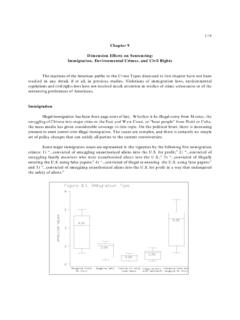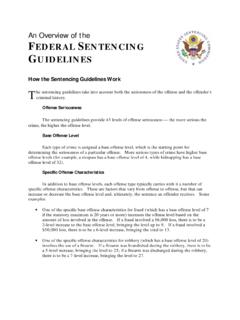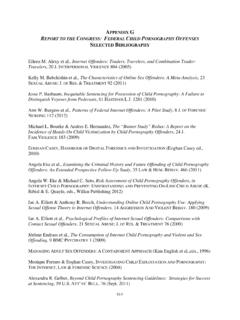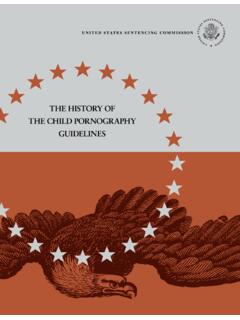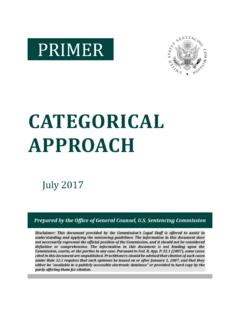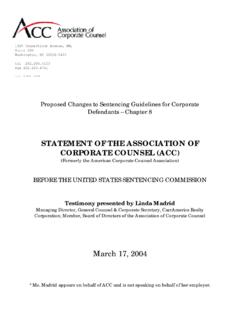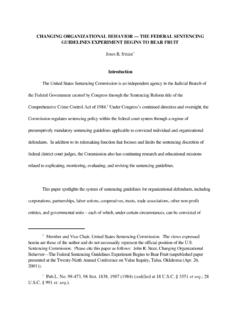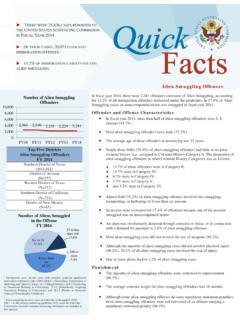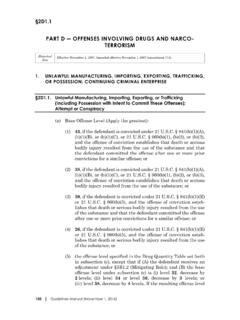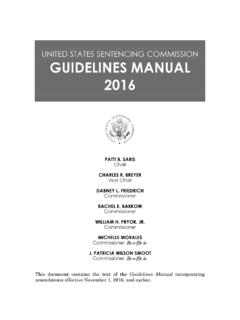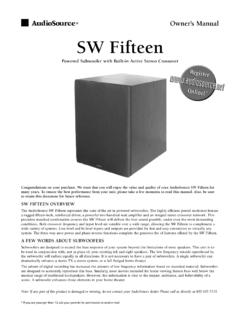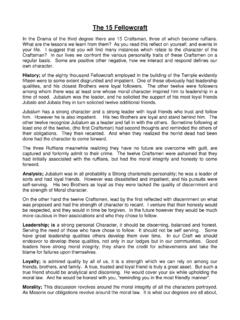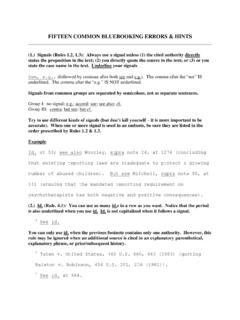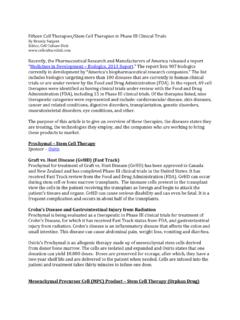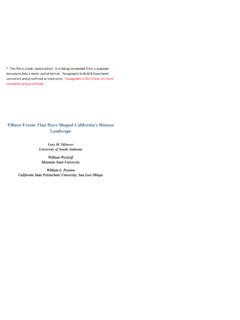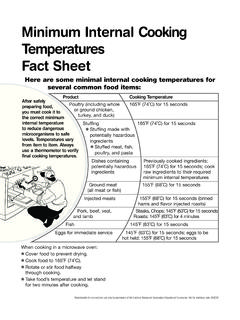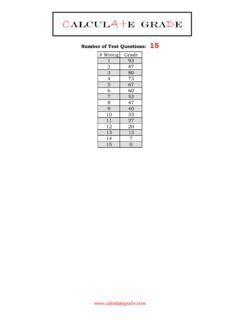Transcription of Fifteen Years of Guidelines Sentencing - November 2004
1 Fifteen Years OFGUIDELINES Sentencing An Assessment of How Well the Federal Criminal Justice System is Achieving the Goals of Sentencing ReformUNITED STATES Sentencing COMMISSIONN ovember 2004 Submitted to Ricardo H. HinojosaChairRuben CastilloVice ChairWilliam K. Sessions, IIIVice ChairJohn R. SteerVice ChairMichael E. HorowitzCommissionerMichael E. O NeillCommissionerDeborah Rhodes(ex officio)Edward F. Reilly, Jr.(ex officio)Prepared byPaul J. HoferCharles LoefflerKevin BlackwellPatricia ValentinoiTable of ContentsExecutive Summary ..ivPreface ..xviiiChapter One: Introduction to the Sentencing Reform Act .. 1A. The History of the Sentencing Reform Act .. 11. The Roots of Reform ..12. Legislative Development of the SRA ..3B. Goals and Purposes of the SRA ..111. The Goals of Sentencing The Purposes of Punishment ..12C. The Commission s Implementation of the SRA .. Drafting Procedures .. the Guidelines Determine the Presumptive Sentence.
2 16D. Components of the Reformed Sentencing System .. 181. Components of Guidelines Development .. 192. Components of Guidelines Implementation .. 22E. From Theory to Two: Impact of the Sentencing Guidelines on the Certainty and Severity of Punishment .. to the Chapter and the Data .. Policy and the Scale of Imprisonment .. the Data .. Increased Certainty of Imprisonment .. Development of Use of Imprisonment in the Federal System . 412. Overall Trends in the Use of Imprisonment .. Increased Severity of Prison Sentences .. Elimination of Parole and the Importance of Time Served .. Trends in Sentencing Severity ..46D. Variations Among Different Offense Types .. Trafficking Offenses .. Offenses ..553. Immigration Offenses .. Trafficking and Possession .. Crimes .. Abuse, Exploitation, and Transportation for Illegal Sexual Activities .. , Severity, and the Scale of Imprisonment .. 751.
3 Policymaking in the Guidelines Era .. Guidelines : A New Instrument of Policy Control .. 77 Chapter Three: Presentencing, Inter-judge, and Regional Disparity .. of Disparity .. Transparency of the Sentencing Decision .. Arising at Presentencing Stages .. Stages That Can Affect Sentencing Uniformity .. Suggest Disparity Results from Presentencing Stages .. Studies Suggest Disparity Results from Presentencing Stages .. the Extent of Disparity Arising at Presentencing Stages .. Stages, Disparity, and the Mechanisms Designed to Control It .. and Regional Sentencing Disparity .. Effects of the Guidelines on Inter-judge and Regional Disparity .. of Inter-judge and Regional Variation in the Preguidelines Era . Concerning the Guidelines Effects on Disparity .. Research Concerning the Guidelines Effects on Disparity .. Disparity Under the Guidelines .. Regional and Inter-judge Disparities .. for Disparity Within the Guidelines System.
4 Upon Motion of the Government .. of Within- Guidelines Sentences .. for Exceptional Circumstances .. 110 Chapter Four: Racial, Ethnic, and Gender Disparities In Federal Sentencing Today .. 113A. Examining Group Differences .. , Discrimination, and Adverse Impacts .. Growing Minority Caseload .. Growing Gap in Sentencing .. Racial, Ethnic, and Gender Discrimination in Sentencing .. Concern in the Guidelines Era .. on Discrimination under the Guidelines .. from Recent Research .. and Ethnic Disparity .. Disparity .. on Departures, Sentencing Options, and Placement Within theGuideline Having Significant Adverse Impacts .. 100-1 Powder to Crack Cocaine Ratio .. Prior Drug Trafficking Convictions to Define Career Offenders ..134 Chapter Five: Summary and Achieved Goals of the SRA .. Rationality and Transparency .. Certainty and Severity of Punishment .. Achieved Goals of the SRA .. of Unwarranted Sentencing Disparity.
5 High Standard of Sentencing Uniformity .. Implementation of the Components of Sentencing Reform .. of Guidelines Implementation .. of Guidelines Policy Development .. Directives to the Commission .. of Article III Judges on the Federal Sentencing Guidelines .. Appendix ..D-1ivExecutive Summary The Sentencing Reform Act of 1984 [hereinafter the SRA] ushered in a new era of sentencingin federal courts. Prior to implementation of the SRA, federal crimes carried very broad ranges ofpenalties, and federal judges had the discretion to choose the sentence they felt would be mostappropriate. They were not required to explain their reasons for the sentence imposed, and thesentences were largely immune from appeal. The time actually served by most offenders wasdetermined by the Parole Commission, and offenders, on average, served just 58 percent of thesentences that had been imposed.
6 The Sentencing process, a critical element of the criminal justiceprocess, was opaque, undocumented, and largely discretionary. Because of its impenetrability tooutside observers, there was a sense that the process was unfair, disparate, and ineffective forcontrolling crime. In order to inject transparency, consistency, and fairness into the Sentencing process,Congress passed the SRA, which established the United States Sentencing Commission [hereinafterthe Commission] and charged it with establishing Guidelines for federal Sentencing . The guidelineswere promulgated in 1987, but district and circuit court rulings prevented their full implementationuntil the Supreme Court, in Mistretta v. United States, 488 361 (1989), affirmed theconstitutionality of the Commission and its work in crafting Guidelines . As a result, in 1991, whenthe Commission issued its report, The Federal Sentencing Guidelines : A Report on the Operationof the Guidelines System and Short-term Impacts on Disparity in Sentencing , Use of Incarceration,and Prosecutorial Discretion and Plea Bargaining [hereinafter called the Four- year Evaluation],there was relatively little data from which the Commission could evaluate the effects of theguidelines.
7 Today the Commission is in a better position to evaluate the success of the guidelinessystem and identify areas for further refinement. This report focuses on three specific assessments:1) the Guidelines impact on the transparency, certainty, and severity of punishment, 2) the impactof the Guidelines on inter-judge and regional disparity, and 3) research on racial, ethnic, and genderdisparities in Sentencing to the Sentencing Reform Act and the GuidelinesGoals and evaluation criteria. The SRA was the result of nine Years of bipartisandeliberation and compromise and, as such, reflects the varied and, at times, competing sentencingphilosophies of its many sponsors and supporters. It set forward the following goals for sentencingreform: 1. elimination of unwarranted disparity;2. transparency, certainty, and fairness;3. proportionate punishment; and4. crime control through deterrence, incapacitation, and the rehabilitation of goals of the new system identified in the SRA provide the best criteria for judgingwhether Sentencing reform has been successful.
8 These goals can be divided into two groups. Thefirst group, the goals of Sentencing reform, include certainty and fairness in punishment and theelimination of unwarranted disparity. Research on the effectiveness of the system at achieving thesegoals is the subject of this report. The second group, establishment of policies that will bestaccomplish the purposes of Sentencing which are usually summarized as just punishment,deterrence, incapacitation, and rehabilitation is the subject of previous Commission-sponsoredresearch as well as ongoing research at the Commission. Development of the Guidelines . The Guidelines promulgated by the Commission were basedon the directives in the SRA and other statutory provisions, as well as on a study of past sentencingpractices. The Commission analyzed detailed data from 10,000 presentence reports and additionaldata on over 100,000 federal sentences imposed in the immediate preguidelines era.
9 TheCommission determined the average prison term likely to be served for each generic type of averages helped establish base offense levels for each crime, which were directly linked toa recommended imprisonment range. Aggravating and mitigating factors that significantly correlatedwith increases or decreases in sentences were also determined statistically, along with each factor smagnitude. These formed the bases for specific offense characteristics for each type of crime,which adjusted the offense level upward or downward. The Commission deviated from past practicewhen it determined there was a compelling reason, such as past under-punishment of white collaroffenses, and when Congress dictated increased severity for an offense category. The Commissionalso factored offenders criminal history into the Guidelines as a way to identify offenders most likelyto recidivate. Real offense Guidelines . The statute-defined elements of many federal crimes fail to providesufficient detail about the manner in which the crime was committed to permit individualizedsentences that reflect the varying seriousness of different violations.
10 In addition, the many,sometimes overlapping provisions in the federal criminal code create the potential that similaroffenses will be charged in many different ways. To better reflect the seriousness of each offender sactual criminal conduct, and to prevent disparate charging practices from leading to sentencingdisparity, the original Commission developed Guidelines that are based to great extent on offenders real offense behavior rather than the charges of conviction alone. Some of the mechanisms to helpameliorate the effects of uneven charging include: 1) the multiple count rules, 2) cross-referencesamong Guidelines , and 3) the relevant conduct rule. In a real offense system, the offender s actualconduct proved at the Sentencing hearing not only the elements of the counts of conviction factorinto the sentence imposed within the statutory penalty range established by the legislature for theoffenses of and Severity of PunishmentTruth-in- Sentencing , mandatory minimums, and Sentencing Guidelines .
